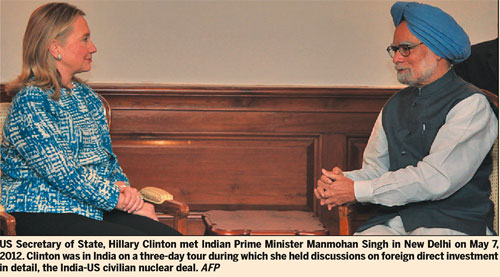US on a tight rope in South Asia
Lynn OCKERSZ
There is certainly a qualitative change in US-India relations and US
Secretary of State Hillary Clinton was not understating the case when
she said in India recently that her country’s ties with India were ‘One
of the defining partnerships of the 21st century.’ This change is best
appreciated by those who have been watching India’s ties with the West
over the decades since 1947, when India gained political independence
from Britain.
The Non-aligned Movement which is somewhat back in the news these
days was a crucial factor in India’s evolving ties with the Western
world. NAM’s historic importance could be best underscored by saying
that the perceptions on world politics of post-independence India’s
principal political leaders and especially their policy pronouncements
favouring neutrality in Cold War politics, proved decisive, initially,
in shaping India’s ties with the West.
For the founding fathers of post-independence India, the policy of
Non-alignment or of strategic neutrality in global politics was of
inestimable value because it enabled India a degree of independence in
her efforts at national development. It was perceived, rightly, that
getting embroiled in Cold War politics would have robbed India of the
independence required to steer a self-determined path to economic and
social betterment.

US foreign policy
But the Western leaders of those times did not read India right. The
US political leadership of the late forties and the fifties tended to
interpret NAM more as a statement of opposition to the basic tenets of
US foreign policy of those early Cold War years. And confronting USSR
military, political and economic power worldwide was a predominant
preoccupation of the US. Indian foreign policy, a cornerstone of which
was Non-alignment, came to be seen as a veritable expression of
non-cooperation with the West in achieving its political and strategic
aims in particularly South Asia. This set the stage for the mostly
strained relations the US had with India over the decades until the
nineties when economic liberalization in India helped to some extent in
bringing about relatively constructive ties between the US and India.
It cannot be argued that by liberalizing her economy to a degree and
repairing her strained ties with the US, India is in a relationship of
subservience to the West in general and the US in particular. Suffice it
to know that the ‘World’s two largest democracies’ have more things in
common now than before and these commonalities are enabling the two
states to enter into a relatively constructive relationship.
But it does not follow from this premise that India is what could be
called a member of the Western camp. On the contrary, she remains
essentially a social democratic state and it is this ideological
orientation that, perhaps, makes her see some commonalities between
herself and the BRICS bloc of states, which currently poses a threat to
Western economic hegemony. The BRICS are: Brazil, Russia, India, China
and South Africa, the up and coming economic powers.
It is the emergence of India as a predominant economic power which is
figuring prominently in the progressive thaw in Indo-US relations. India
is today so great an economic power that she is prompting the foremost
political leaders of the West to enter into a closer interaction with
her and in this regard the Indo-US accord to launch closer ties of
cooperation in the civilian nuclear field should not be allowed to pass
unnoticed.
The US is also in the process of strengthening business and
commercial links between the countries. Besides, there is the
consideration on the part of the US that perceived Chinese influence in
South and South-East must be contained and closer ties with India, it is
believed, could serve this aim.
Oil reserves
On the other hand, US ties with traditional ally in South Asia,
Pakistan, are far from smooth at present. As could be seen, the Western
military engagement in Afghanistan is causing destabilizing ripples in
US-Pakistan ties and the question that perceptive sections in Pakistan
ask is why their country too has to bear the brunt of the turmoil in
Afghanistan in the form of, for instance, US drone attacks which are
tending to exact a considerable death toll in their land.
The point to be noted is that the US’ security worries are far from
over in the South-West Asia theatre. It is little realized that these
worries have been dogging the US from the late forties when conservative
US administrations sought a foothold in the strategically important
region of Kashmir. Curiously, this business of a security nature is far
from over.
Although the need to cripple the Al-qaeda terror network and its
allies is being cited in US political circles as the reasons for
continued Western military involvement in Afghanistan, it was right
along the aim of the US to have a strong strategic presence in
South-West Asia and the Persian Gulf region for the obvious reason of
keeping a watch over the region’s oil reserves. This design suffered a
setback with the ousting of the Shah of Iran, a strong US ally, in 1979.
Since then the US has considered it in its interests to maintain a
visible military presence in South West Asia.
It could be seen, then, that the US is on a tight rope in our part of
the world. On the one hand, it needs to cultivate closer ties with ‘the
world’s most populous democracy’, which is India, speak the language of
liberal democracy and uphold the norms that go along with it, while
militarizing its ties in South West Asia. There is a perplexing policy
dilemma here that needs to be resolved. The US cannot uphold democratic
development while pursuing a ‘law and order’ approach to the terror
phenomenon, which is usually antithetical to democratic advancement. The
non-resolution of this contradiction would expose US policy as
conceptually flawed in a fundamental sense. |



